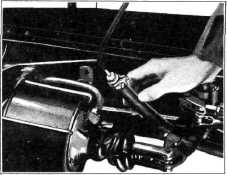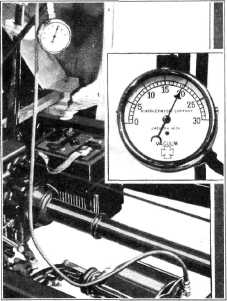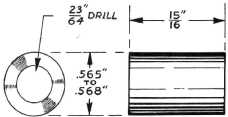1942 - 1947 CHEVROLET SHOP MANUAL
Section 5 - Brakes
|
|
|||
|
5-14 |
|||
|
|
|||
|
Testing for Leakage
1. Remove the pipe plug from the front end of
the power cylinder and attach a
vacuum gauge at this
point.
2. Start the engine and note the vacuum gauge
reading, which should show
between 16 and 20 inches of vacuum. (Fig. 31.)
3. Stop the engine. If the vacuum gauge shows
a rapid falling off, leakage is
indicated which may be in the power cylinder, check valve, or vacuum line to the intake
manifold. |
If this is the case, the check
valve should be removed, disassembled, and cleaned. The vacuum line and connection should be inspected
and tightened and damaged
hoses replaced. Then make
another test to make sure the leak has been
corrected. |
||
 |
|||
 |
|||
|
Fig. 32—Vacuum Gauge Hook-Up far
Checking Vacuum Line and Check Valve for Air Leaks
Power Cylinder
If from the
previous test the leak is found to be in the power cylinder, it should be
lubricated as instructed under
"Lubrication." Then another test should be made to make sure the trouble
has been corrected.
ADJUSTMENTS Brake
Valve
The brake valve must be checked
for correct adjustment when any
tests of the system have been made. Accurate valve adjustment is a very
important item in servicing reactionary power cylinders.
Care must be exercised in this operation and proper methods used if satisfactory results
are to be expected.
Valve
adjustment must be made with the engine running at idling speed.
A special bushing is used to make
the valve adjustment. This
bushing is easily made up from brass or steel, to the dimensions shown in
Fig. 33, |
|||
|
Fig. 31— Checking Braking System far Air Leaks
Testing Vacuum Line and Check Valve
1. Disconnect the vacuum hose at the power
cylinder and attach the
vacuum gauge to the end of the
hose. Fig. 32.
2. Start the engine and note the vacuum gauge
reading, which should show
between 16 to 20 inches of
vacuum.
3. Stop the engine. If the vacuum is retained
for a reasonable length of
time, the check valve and
vacuum line are OK, indicating that the leak is in the power cylinder. However, if
the gauge should show a rapid
falling off, then the leakage
is indicated in the check valve or vacuum line. |
|||
 |
|||
|
Fig. 33—Vacuum Valve Adjusting
Bushing |
|||
|
|
|||